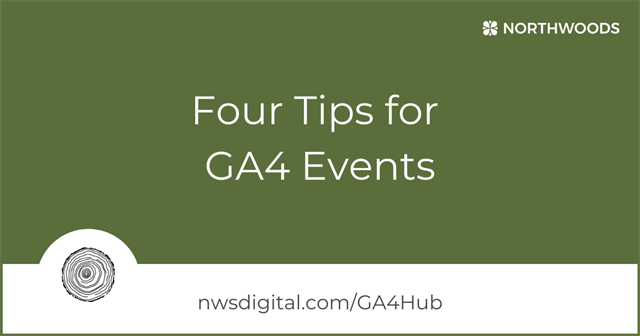By Fred Pike
May 18, 2023
4 Minute Read
Updated: May 18, 2023
Originally Published: May 20, 2022
As of July 1, 2023, Universal Analytics (UA – also called GA3) will no longer accept any incoming traffic – i.e. the last day for which you’ll have any traffic captured in GA3 will be June 30, 2023.
This Google announcement created a bit of panic in the digital marketing community (to say the least).
What does this announcement mean, though, and what should you do? Here is a high-level outline of the steps you need to take to have continuity in your analytics:
1) Get GA4 on your website now.
To do this, install the GA4 tracking tag, preferably through Google Tag Manager (GTM).
If you haven’t already, at a minimum you want to start sending traffic to GA4. It’s a fairly easy process to create a GA4 account and add the GA4 tag to GTM. If you do nothing else, you will at least be tracking what Google calls the “enhanced measurement” events:
- Page views
- Outbound Links
- Search Terms
- YouTube Video plays (if they’re embedded on your site)
- Downloaded files
2) If you are tracking events in GA3, take a hard look at them (Behavior > Events > Top Events).
Decide which events are valuable enough to move to GA4. We strongly recommend not moving all events over – only move events that are meaningful and that help drive the business forward. Take the Marie Kondo approach: Does this event bring you joy? If so, move it to GA4.
3) When deciding which GA3 events to move over to GA4, plan on expanding the information you track.
One of the biggest advantages of GA4 is its ability to richly describe each event.
GA4 uses an event-driven data model. It has an event name (e.g. form_submitted) followed by up to 25 parameters that describe that event. This is a huge improvement over GA3.
Sample parameters for the form_submitted event might include:
- Form name
- Form type
- Material requested
- Source of the lead (organic, paid traffic, Facebook/Instagram ads, etc.)
4) As you choose the GA3 events to move over, decide what to call them and which parameters to use.
Our recommendations:
- If relevant, use event names from Google’s list of recommended events (see the resource list of GA4 events and parameters, below).
- If you create your own event name, make it complete and descriptive (e.g. form_submitted, form_started, form_errors, etc.). "Verbose nomenclature" is what you're after – no cryptic names.
- You can have up to 500 event names in GA4, so feel free to be creative and fine-grained.
- Use existing parameter names as much as possible (again, see the list of GA4 events and parameters resource, below). Unlike event names, with parameters you need to be judicious in your naming; you'll want to re-use names as much as possible.
- You're limited to 50 parameter names in the UI, so don't create random parameter names.
- All event names and event parameters should use “snake_case” – all lowercase letters, with spaces represented by an underscore.
- this_is_acceptable_snake_case
- this_is_NOT_snakeCase
5) After you set up GA4, you’ll have some work to do in the Admin section.
- Change the data retention from 2 months to 14 months
- Make sure the search query settings correspond to your search query parameters
- Match your GA3 cross-domain tracking (if you have it set up) in GA4
- Link your Google Ads account
- Link your Google Search Console account
- Set up internal filters for your traffic
- Set up Google signals, if your privacy policy allows that
6) If you are using GA3’s enhanced e-commerce (EEC), you’ll have some decisions to make.
- Re-purpose your GA3 EEC implementation for GA4. This is a short-term solution.
- Better yet, set up the GA4 e-commerce events and dataLayer pushes. This is a much better solution. The GA4 e-commerce model is cleaner and simpler and, while it’s missing some functionality now, count on more functionality to be added.
7) Set up a BigQuery account (part of the Google Cloud Platform).
GA4’s built-in BigQuery integration is another huge advantage for GA4. You have the option of sending all of your data to BigQuery, where you will then own the data. You’ll have full access to the data – no sampling, no risk of deletion, no cardinality. You can slice and dice it to your heart’s content. While there may be a cost involved, for most small and medium sized business, it’ll be minimal – the free tier of BigQuery is quite generous:
- The first 10GB of storage each month is free
- Queries/analysis - the first 1TB of query data processed is free
8) Run GA3 and GA4 side by side.
There’s no downside to running both. You're building up your history in GA4, which is good.
In the meantime, continue using GA3. With its familiar interface, it's the place to rely on for your analysis needs.
If all of these steps seem overwhelming, know that Northwoods can help you with any or all of them. Our team can make this transition as easy as possible for you, so please don't hesitate to reach out!
Important GA4 Dates
- July 1, 2023 | GA3 will stop accepting new data (Sept. 30, 2023 if you have the 360 version of UA)
- January 1, 2024 (possibly later) | ALL of your GA3 data will disappear. In their announcement, Google said: "After that (July 1, 2023), you'll be able to access your previously processed data in Universal Analytics for at least six months."
* Do not count on the July 1, 2023 date to slip – Google insists that'll be the end of GA3.
Final Thoughts
You may not be happy with this announcement (very few people are), and you may grumble about the stuff that’s missing in GA4 (e.g. views).
Keep in mind, though, that Google is pouring development resources into GA4. Expect significant improvements and additions over the next year.
So, get cracking! Make sure you have GA4 installed on your website. And, again, don't hesitate to reach out to us for help with any or all of these steps.
Resources
Related Blog Posts
A list of setup tips for Google Analytics 4 (GA4). Tips cover filters for both hostname and internal traffic; creating custom insights to warn you of low traffic and other anomalies; setting up tracking of search terms entered on your site, etc.

Want to improve your Google Analytics event data collection? Try these four tips for GA4 events.

Today’s digital marketers must collect and analyze a significant amount of data. How does a marketer begin to make sense of it all? Data visualization! Here’s how to get started.